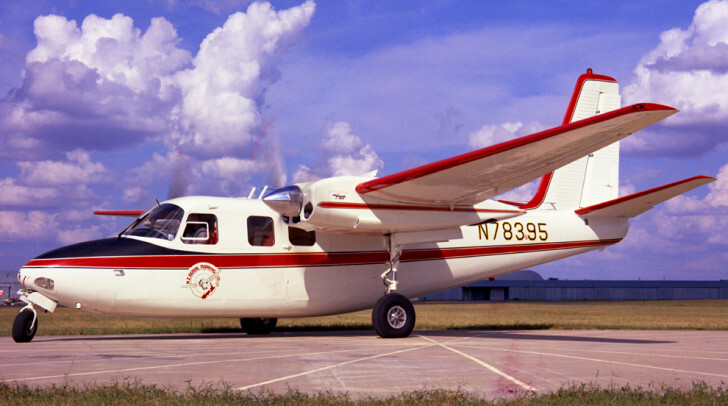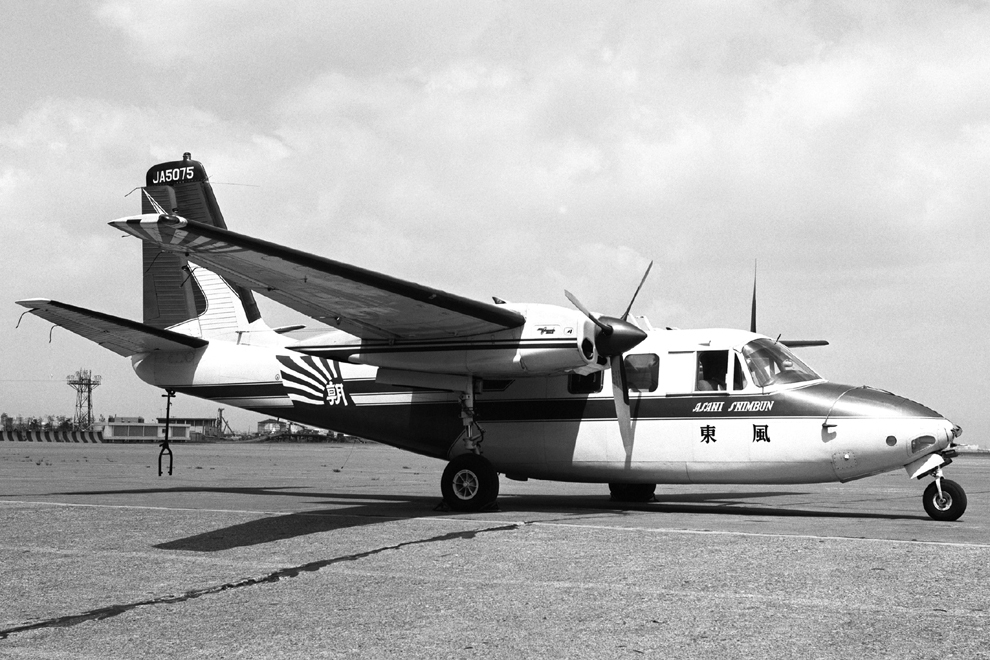
This photo, scanned from a factory negative, is of N78395, originally certificated on August 23, 1963 and painted in a special design in Bluetone White, Scarlet Bleeder Red, and Black. After being modified by installing a camera facility, it was delivered by Air Ferry International Inc., of Pacific Palisades, California, to Auckland, New Zealand, to the New Zealand Land & Survey Department of Hastings, which owned it jointly with NZ Aerial Mapping Ltd., whose logo can be seen underneath the pilot’s window. Also clearly seen at the front of the nacelle are three intakes.
The Model 680F was the eleventh Commander model to be placed into production. The first 23 were built by the Aero Design & Engineering Company, a subsidiary of Rockwell-Standard Corporation, at Bethany (Wiley Post Airport) in Oklahoma City. The next 79 were produced by Aero Commander Inc., also a subsidiary of Rockwell-Standard Corporation. The last three were built by the Aero Commander Division of Rockwell-Standard Corporation.
All 105 aircraft were produced between May 1960 and October 1964, with serial numbers in the range 680F-871-1 through 680F-1447-152, although the first one was converted from a 500A, serial number 500A-871-1.
Of these, 41 were initially certified in 1960; 32 in 1961; 28 in 1962; two in 1963; and two in 1964.
However, these serial numbers also included examples of a pressurized version, the 680F(P). However, this wasn’t certified as a new model, as the pressurization package was considered an option.
The 47 aircraft designated as the 680F(P) were within the serial number range 680F-1048-56 through 680F-1439-151. The FAA granted certification approval of the 680F(P) on June 29, 1962.
A factory document describes the Model 680F, under Wing Drawing 5170045, as “the same as the Model 680E except for, a) gross weight increased to 8000 pounds; b) Lycoming IGSO-540-B1A engines; and c) redesigned nacelle and main gear. The 680F was certified on August 23, 1960 per CAR 3, May 15, 1956, Amendments 3-3 and 3-4.”
The Model 680F was indeed certified on August 23, 1960, under Type Certificate 2A4 with 340 hp Lycoming IGSO-540-B1A engines and 93.5-inch-diameter three-blade Hartzell HC-B3Z30-2B propeller hubs with 9349 model blades. Gross weight is 8,000 pounds.
It was the first Commander model to have both supercharged and fuel-injected engines. Serial number 680F-1000-39, the 39th 680F, was the 1,000th production Commander built.

Painted in Factory Design #1-60 in Polar White and Baltic Blue as N6137X, this Model 680F was originally certificated on January 6, 1961, with 67-gallon auxiliary fuel tanks. It was delivered by the Air Carrier Service Corp., of Washington, DC, to the Asahi-Shimbun Newspaper Company in Tokyo, Japan. Prior to delivery a temporary ferry fuel system comprising 300 gallons was installed. It remained in service until May 1982 when it was withdrawn from use and placed on display with the Modern Transport Museum in Osaka, Japan.
Note the co-pilot’s window has been modified to allow it to slide back to allow for photography to illustrate news items. As a model recognition feature, note the three nacelle intakes, a common feature along with the Model 560F. Other models in the group, the 500B, 500U & 500S, only have two such intakes.
On September 20, 1960, Geraldyn “Jerrie” M. Cobb established a new world record for altitude, reaching 11,257 meters (equating to 36,932.41 feet) at Santa Monica, California, in N6139X, serial number 680F-920-2. An Experimental – Demonstration category Certificate of Airworthiness had previously been issued on September 17. However, the 1960-61 edition of “Jane’s All The World’s Aircraft” quotes “Flying a standard Model 680F, Miss Jerrie Cobb set up an international class C-1.d height record of 37,010 ft. (11,281m.) on September 20, 1960,” while the 1961-62 edition quotes “Flying a standard Model 680F, Miss Jerrie Cobb set up an international class C-1.d height record of 36,932 ft. (11,257m.) on September 20, 1960.”
Four Model 680Fs were modified to Mr. RPM (Richard P. MacCoon) “Turbo 800s” under STC SA2691WE. These had the 400-hp Lycoming IO-720-B1B(D) engines, modified with the installation of a Rajay turbocharger system under STC SE62WE, coupled with 80.625-inch-diameter Hartzell HC-A3VK-2A/V8433(B)-4R propellers.
Barry Collman’s lifelong interest in airplanes began when he was growing up in a house located underneath the downwind leg to busy Northolt aerodrome, an R.A.F. base near London-Heathrow airport. As a young teenager he discovered airplane “spotting”–hobbyists’ observation and logging of aircraft by make, model, and registration number. The hobby began to grow into a passion as Collman joined a club of like-minded spotters. At one point he purchased a copy of the January 1966 U.S. Civil Aircraft Register, and thumbing through it came upon the Aero Commander. He was hooked. Eventually he acquired every available FAA microfiche file on Commanders, and since 1995 has made annual pilgrimages to Oklahoma City to sift through FAA records. He now has a database with more than 96,100 records as well as a collection of negatives, slides, photographs, digital images, magazines, brochures, knick-knacks–and a very understanding wife. This series on Commander production history originally was written for the Twin Commander Flight Group, of which he is an enthusiastic member.
